Impacts of Tibetan Plateau Spring Snowmelt on Spring and Summer Precipitation in Northwest China
Abstract
1. Introduction
2. Data and Methodology
3. Characteristics of Spatiotemporal Variations in TP Spring Snowmelt
4. Influence of the TP Spring Snowmelt on Precipitation in NWC
4.1. Relationship between the TP Spring Snowmelt and Spring Precipitation in NWC
4.2. Relationship between the TP Spring Snowmelt and Summer Precipitation in NWC
4.3. Composite Analysis of Spring and Summer Precipitation Anomalies in NWC
5. Possible Mechanisms Linked to the Impact of TP Spring Snowmelt on Spring and Summer Precipitation in NWC
6. Conclusions and Discussion
- Snow accumulation mainly occurred during autumn and snowmelt, and was larger in spring than in summer. Over the past 40 years, both the snow depth and snowmelt have shown significant decreasing trends. Additionally, large interannual variations in snowmelt occurred over the eastern TP;
- There was a significant relationship between spring snowmelt and spring and summer precipitation in NWC. In particular, the larger the spring snowmelt over the whole TP, especially in the central eastern TP, the more spring and summer precipitation in the Hexi Corridor and southeast NWC (which was more significant in summer). Additionally, larger spring snowmelts in the northern TP resulted in less spring and summer precipitation in NWC, whereas larger spring snowmelts in the western TP led to more spring and summer rainfall in western NWC and less in eastern NWC (which was also more significant in summer);
- Spring snowmelt had a significant impact on soil moisture, and soil moisture anomalies that were related to snowmelt anomalies could persist from spring to summer, leading to anomalies in surface diabatic heating. Specifically, a large spring snowmelt over the TP could lead to weaker easterly and westerly winds at the north and south sides of the TP, respectively. Additionally, the subtropical westerly jet streams at 200hPa became weaker and their positions shifted southward. Correspondingly, the enhancement of the ridge over the Xinjiang ridge and southern trough transported water vapor to NWC, thus causing excessive summer precipitation in that region.
Author Contributions
Funding
Institutional Review Board Statement
Informed Consent Statement
Data Availability Statement
Acknowledgments
Conflicts of Interest
References
- Barnett, T.P.; Dümenil, L.; Schlese, U.; Roeckner, E. The effect of Eurasian snow cover on global climate. Science 1988, 239, 504–507. [Google Scholar] [CrossRef] [PubMed]
- Cohen, J.; Rind, D. The effect of snow cover on the climate. J. Clim. 1991, 4, 689–706. [Google Scholar] [CrossRef]
- Yasunari, T.; Kitoh, A.; Tokioka, T. Local and remote responses to excessive snow mass over Eurasia appearing in the northern spring and summer climate: A study with the MRI•GCM. J. Meteorol. Soc. Jpn. 1991, 69, 473–487. [Google Scholar] [CrossRef]
- Zhang, T.J. Influence of the seasonal snow cover on the ground thermal regime: An overview. Rev. Geophys. 2005, 43, RG4002. [Google Scholar] [CrossRef]
- Tang, Z.; Wang, J.; Li, H.; Yan, L. Spatiotemporal changes of snow cover over the Tibetan Plateau based on cloud-removed moderate resolution imaging spectroradiometer fractional snow cover product from 2001 to 2011. J. Appl. Remote Sens. 2013, 7, 2431. [Google Scholar] [CrossRef]
- Zhang, S.L.; Tao, S.Y. Influences of snow cover the Tibetan Plateau on Asian summer monsoon. Chin. J. Atmos. Sci. 2001, 25, 372–390. (In Chinese) [Google Scholar] [CrossRef]
- Zhang, Y.S.; Li, T.; Wang, B. Decadal change of the spring snow depth over the Tibetan Plateau: The associated circulation and influence on the East Asian summer monsoon. J. Clim. 2004, 17, 2780–2793. [Google Scholar] [CrossRef]
- Wu, B.Y.; Yang, K.; Zhang, R.H. Eurasian snow cover variability and its association with summer rainfall in China. Adv. Atmos. Sci. 2009, 26, 31–44. [Google Scholar] [CrossRef]
- Qiu, J. Tibetan plateau gets wired up for monsoon prediction. Nature 2014, 514, 16–17. [Google Scholar] [CrossRef]
- Pu, Z.; Xu, L.; Salomonson, V.V. MODIS/Terra observed seasonal variations of snow cover over the Tibetan Plateau. Geophys. Res. Lett. 2007, 34, L06706. [Google Scholar] [CrossRef]
- Tang, Z.; Deng, G.; Hu, G.; Zhang, H.; Pan, H.; Sang, G. Satellite observed spatiotemporal variability of snow cover and snow phenology over High Mountain Asia from 2002 to 2021. J. Hydrol. 2022, 613, 128438. [Google Scholar] [CrossRef]
- Deng, G.; Tang, Z.; Hu, G.; Wang, J.; Li, J. Spatiotemporal dynamics of snowline altitude and their responses to climate change in the Tianshan Mountains, Central Asia, During 2001–2019. Sustainability 2021, 13, 3992. [Google Scholar] [CrossRef]
- Liu, X.; Yanai, M. Influence of Eurasian spring snow cover on Asian summer rainfall. Int. J. Climatol. 2002, 22, 1075–1089. [Google Scholar] [CrossRef]
- Wu, T.W.; Qian, Z.A. The relation between the Tibetan winter snow and the Asian summer monsoon and rainfall: An observational investigation. J. Clim. 2003, 16, 2038–2051. [Google Scholar] [CrossRef]
- Zhao, P.; Zhou, Z.J.; Liu, J.P. Variability of Tibetan spring snow and its associations with the hemispheric extratropical circulation and east Asian summer monsoon rainfall: An observational investigation. J. Clim. 2007, 20, 3942–3955. [Google Scholar] [CrossRef]
- Wu, R.; Kirtman, B.P. Observed relationship of spring and summer East Asian rainfall with winter and spring Eurasian snow. J. Clim. 2007, 20, 1285–1304. [Google Scholar] [CrossRef]
- Zhang, J.; Ma, Q.R.; Chen, H.S. Increasing warm-season precipitation in Asian drylands and response to reducing spring snow cover over the Tibetan Plateau. J. Clim. 2021, 34, 3129–3144. [Google Scholar] [CrossRef]
- Wu, Z.W.; Li, J.P.; Jiang, Z.H.; Ma, T.T. Modulation of the Tibetan Plateau snow cover on the ENSO teleconnections: From the East Asian summer monsoon perspective. J. Clim. 2012, 25, 2481–2489. [Google Scholar] [CrossRef]
- Si, D.; Ding, Y.H. Decadal change in the correlation pattern between the Tibetan Plateau winter snow and the east Asian summer precipitation during 1979–2011. J. Clim. 2013, 26, 7622–7634. [Google Scholar] [CrossRef]
- Zhu, Y.X.; Liu, H.W.; Ding, Y.H.; Zhang, F.Y.; Li, W. Interdecadal variation of spring snow depth over the Tibetan Plateau and its influence on summer rainfall over East China in the recent 30 years. Int. J. Climatol. 2015, 35, 3654–3660. [Google Scholar] [CrossRef]
- Senan, R.; Orsolini, Y.J.; Weisheimer, A.; Vitart, F.; Balsam, G.; Stockdale, T.N.; Dutra, E.; Francisco, J.; Basang, D. Impact of springtime Himalayan-Tibetan Plateau snowpack on the onset of the Indian summer monsoon in coupled seasonal forecasts. Climate. Dyn. 2016, 47, 2709–2725. [Google Scholar] [CrossRef]
- Xiao, Z.X.; Duan, A.M. Impacts of Tibetan Plateau snowcover on the interannual variability of the East Asian summer monsoon. J. Clim. 2016, 29, 8495–8514. [Google Scholar] [CrossRef]
- Wang, C.H.; Yang, K.; Li, Y.L.; Wu, D.; Bo, Y. Impacts of spatiotemporal anomalies of Tibetan Plateau snow cover on summer precipitation in Eastern China. J. Clim. 2017, 30, 885–903. [Google Scholar] [CrossRef]
- Wang, Z.; Wu, R.; Zhao, P.; Yao, S.-L.; Jia, X. Formation of snow cover anomalies over the Tibetan Plateau in cold seasons. J. Geophys. Res. Atmos. 2019, 124, 4873–4890. [Google Scholar] [CrossRef]
- Yuan, C.; Li, W.; Guan, Z.; Yamagata, T. Impacts of April snow cover extent over Tibetan Plateau and the central Eurasia on Indian Ocean dipole. Int. J. Climatol. 2019, 39, 1756–1767. [Google Scholar] [CrossRef]
- Mu, S.N.; Zhou, G.Q. Analyses of seasonal fresh snow extent over Northern Eurasia. Chimatic Environ. Res. 2009, 14, 491–508. (In Chinese) [Google Scholar] [CrossRef]
- Xiao, Z.; Duan, A.; Wang, Z. Atmospheric heat sinks over the western Tibetan Plateau associated with snow depth in late spring. Int. J. Climatol. 2019, 1–11. [Google Scholar] [CrossRef]
- Wu, T.W.; Qian, Z.A.; Li, P.J.; Song, M.H.; Ma, X.B. Some comparative analyses of precipitation over Northwest China drought area after the Qinghai-Xizang Plateau heavy-and light-snow years. Plateau Meteor. 1998, 17, 364–372. (In Chinese) [Google Scholar] [CrossRef]
- Wang, C.H.; Dong, A.X.; Wang, S.G.; Yang, D.B. The correlation between precipitation in Northwest China during spring and snow depth in the Tibetan Plateau. J. Glaciol. Geocryol. 2000, 22, 340–346. (In Chinese) [Google Scholar] [CrossRef]
- Wang, Z.L.; Li, Y.H.; Wang, J.S.; Chen, L.Y. Relationship between abnormal snow depth in winter and spring in Tibetan Plateau and spring-summer precipitation in Northwest China based on SVD analysis. J. Arid Meteor. 2015, 33, 363–370. (In Chinese) [Google Scholar] [CrossRef]
- Shi, Y.F.; Shen, Y.P.; Li, D.L.; Zhang, G.W.; Ding, Y.J.; Hu, R.J.; Kang, E.S. Discussion on the present climate change from warm-dry to warm-wet in Northwest China. Quat. Sci. 2003, 23, 152–164. (In Chinese) [Google Scholar] [CrossRef]
- Sui, Y.; Jiang, D.B.; Tian, Z.P. Latest update of the climatology and changes in the seasonal distribution of precipitation over China. Theor. Appl. Climatol. 2013, 113, 599–610. [Google Scholar] [CrossRef]
- Xu, D.; Li, R.L.; Wang, C.H. Characteristics of precipitation changes and relationships with water vapor transport in typical arid regions of Asia and Africa under global warming. Climatic Environ. Res. 2016, 21, 737–748. (In Chinese) [Google Scholar] [CrossRef]
- Li, J.M.; Wang, C.H. An evaporation correction approach and its characteristics. J. Hydrol. 2020, 21, 519–532. [Google Scholar] [CrossRef]
- Li, R.L.; Wang, C.H. Precipitation recycling using a new evapotranspiration estimator for Asian-African arid regions. Theor. Appl. Climatol. 2020, 140, 1–3. [Google Scholar] [CrossRef]
- Wang, C.H.; Zhang, S.N.; Li, K.C.; Zhang, F.M.; Yang, K. Change characteristics of precipitation in Northwest China from 1961 to 2018. Chin. J. Atmos. Sci. 2021, 45, 713–724. (In Chinese) [Google Scholar] [CrossRef]
- Wang, Q.; Zhai, P.M.; Qin, D.H. New perspectives on ‘warming-wetting’ trend in Xinjiang, China. Adv. Clim. Chang. Res. 2020, 11, 252–260. [Google Scholar] [CrossRef]
- Zhang, J.; Liu, C.; Chen, H. The modulation of Tibetan Plateau heating on the multi-scale northernmost margin activity of East Asia summer monsoon in northern China. Global. Planet. Chang. 2018, 161, 149–161. [Google Scholar] [CrossRef]
- Che, T.; Li, X.; Jin, R.; Armstrong, R.; Zhang, T. Snow depth derived from passive microwave remote-sensing data in China. Ann. Glaciol. 2008, 49, 145–154. [Google Scholar] [CrossRef]
- Ding, Y.G.; Jiang, Z.H. Generality of singular value decomposition in diagnostic analysis of meteorological field. Acta. Meteorol. Sin. 1996, 54, 365–372. (In Chinese) [Google Scholar] [CrossRef]
- Wang, C.H.; Wang, Z.L.; Cui, Y. Snow cover of China during the last 40 years: Spatial distribution and interannual variation. J. Glaciol. Geocryol. 2009, 31, 301–310. Available online: http://ir.casnw.net/handle/362004/20228 (accessed on 7 July 2020). (In Chinese).
- Li, X.L.; Zhang, F.M.; Wan, C.H. Comparison and analysis of snow depth over China, observed and derived from remote sensing. J. Glaciol. Geocryol. 2012, 34, 755–764. (In Chinese) [Google Scholar]
- Wang, T.; Li, Z.G.; LÜ, S.H.; Yao, C.; Ma, S.L. Study on the Effects of Snow Cover on Heat Transport in Land Surface Processes over Qinghai-Tibetan Plateau. Plateau Meteor. 2019, 38, 920–934. (In Chinese) [Google Scholar] [CrossRef]
- North, G.R.; Bell, T.L.; Cahalan, L.F.; Moeng, F.J. Sampling errors in the estimation of empirical orthogonal functions. Mon. Wea. Rev. 1982, 110, 699–706. [Google Scholar] [CrossRef]
- Shi, Y.F.; Shen, Y.P.; Hu, R.J. Preliminary study on signal, impact and foreground of climatic shift from warm-dry to warm-humid in Northwest China. J. Glaciol. Geocryol. 2002, 24, 219−226. (In Chinese) [Google Scholar] [CrossRef]
- Wang, Z.B.; Wu, R.G.; Chen, S.F.; Huang, G.; Liu, G.; Zhu, L.H. Influence of western Tibetan plateau summer snow cover on east Asian summer rainfall. J. Geophys. Res. Atmos. 2018, 123, 2371–2386. [Google Scholar] [CrossRef]
- Thomas, L.M. On the role of snow cover in depressing air temperature. J. Applied Meteor. Climatol. 2008, 47, 2008–2022. [Google Scholar] [CrossRef]
- Zhu, Y.X.; Ding, Y.H.; Xu, H.G. Decadal relationship between atmospheric heat source of winter and spring snow over Tibetan Plateau and rainfall in east China. Acta Meteor. Sin. 2008, 22, 303–316. (In Chinese) [Google Scholar] [CrossRef]
- Ding, Q.; Wang, B. Circumglobal teleconnection in the Northern Hemisphere summer. J. Climate. 2005, 18, 3483–3505. [Google Scholar] [CrossRef]
- Du, Y.; Zhang, Y.C.; Xie, Z.Q. Impacts of the zonal position of the East Asian westerly jet core on precipitation distribution during Meiyu of China. Acta Meteor. Sin. 2009, 23, 506–516. Available online: http://jmr.cmsjournal.net/en/article/id/1206?articleType=archive_en (accessed on 8 March 2020).
- Chen, G.; Sawada, M.; Iwasaki, T. Influence of summer monsoon diurnal cycle on moisture transport and precipitation over eastern China. J. Geophys. Res. Atmos. 2013, 118, 3163–3177. [Google Scholar] [CrossRef]
- Herzschuh, U. Coauthors, Position and orientation of the westerly jet determined Holocene rainfall patterns in China. Nat. Commun. 2019, 10, 2376. [Google Scholar] [CrossRef] [PubMed]
- Zhang, J.; Chen, Z.; Chen, H.; Ma, Q.; Teshome, A. North Atlantic multidecadal variability enhancing decadal extra tropical extremes in boreal late summer in the early twentyfirst century. J. Clim. 2020, 33, 6047–6064. [Google Scholar] [CrossRef]
- Chen, F.; Chen, J. A discussion on the westerly-dominated climate model in mid-latitude Asia during the modern interglacial period. Earth Sci. Front. 2012, 279–280, 86–87. [Google Scholar] [CrossRef]
- Bothe, O.; Fraedrich, K.; Zhu, X. Precipitation climate of Central Asia and the large-scale atmospheric circulation. Theor. Appl. Climatol. 2012, 108, 345–354. [Google Scholar] [CrossRef]
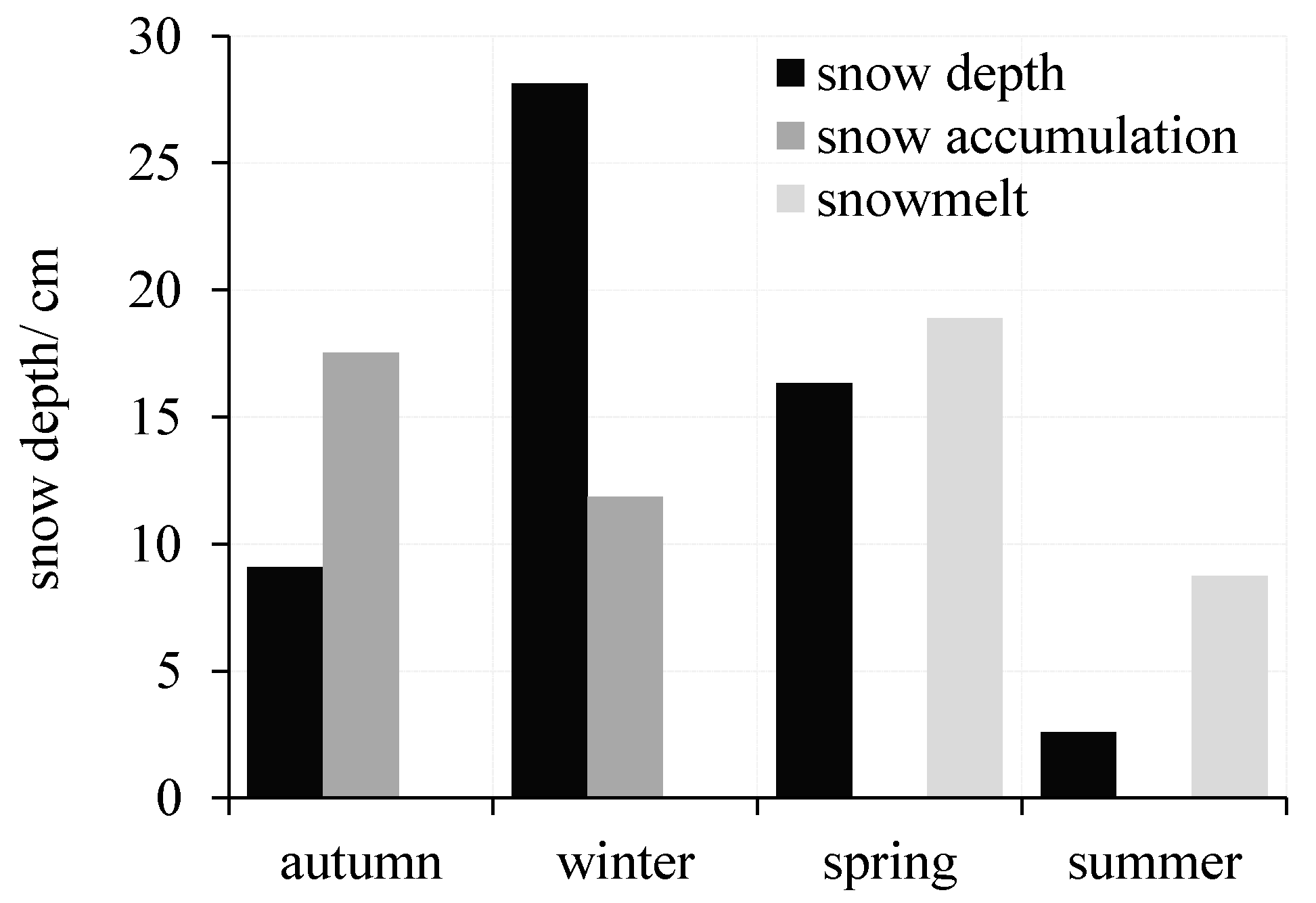
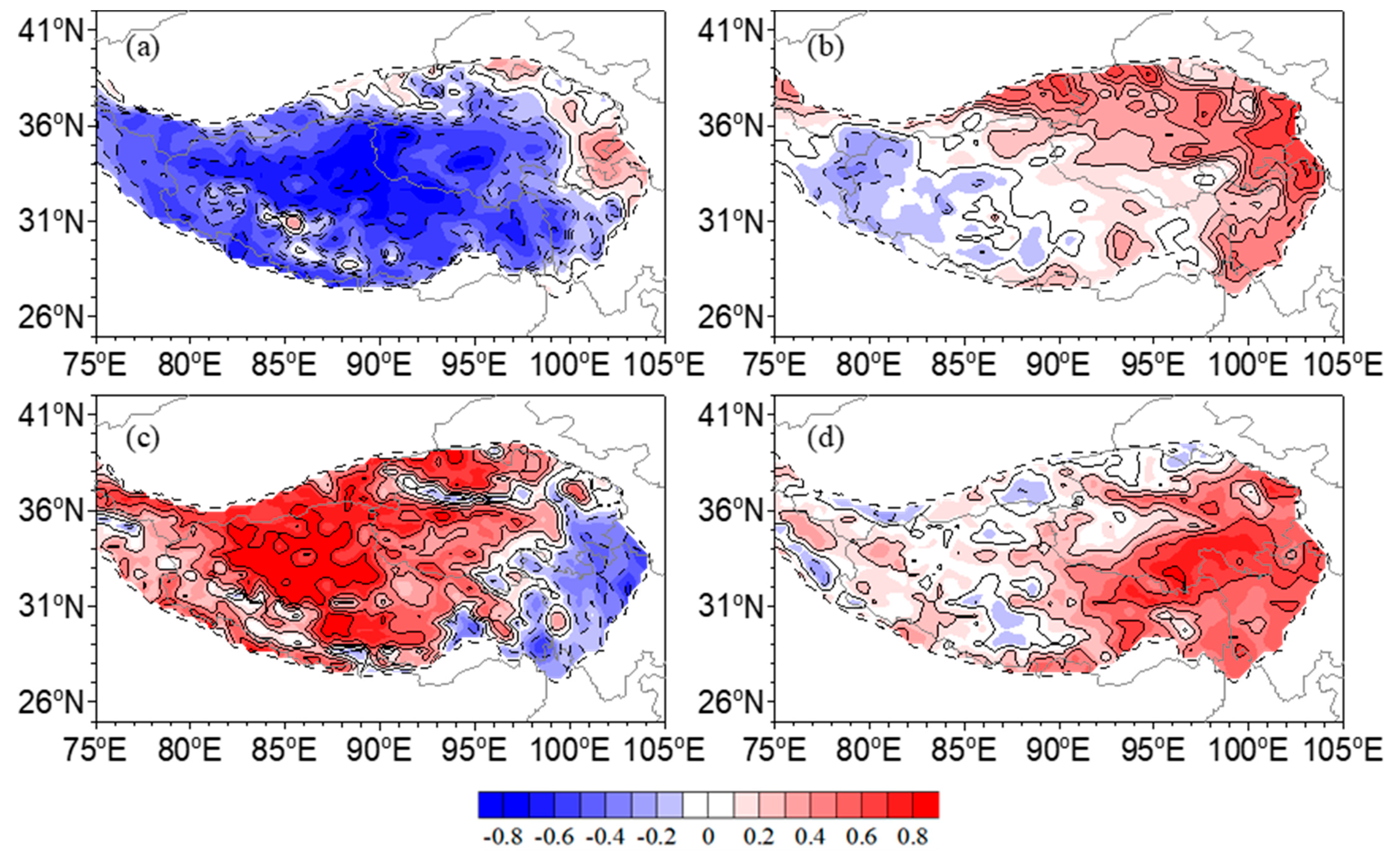
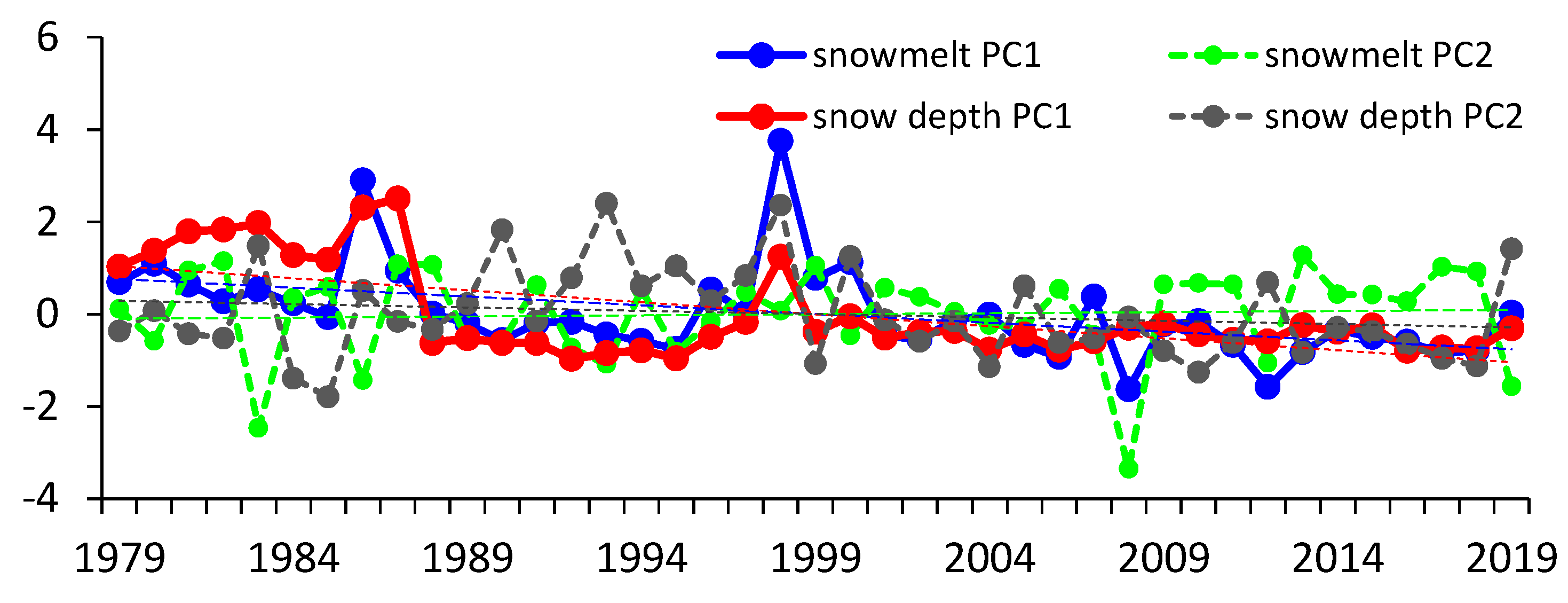
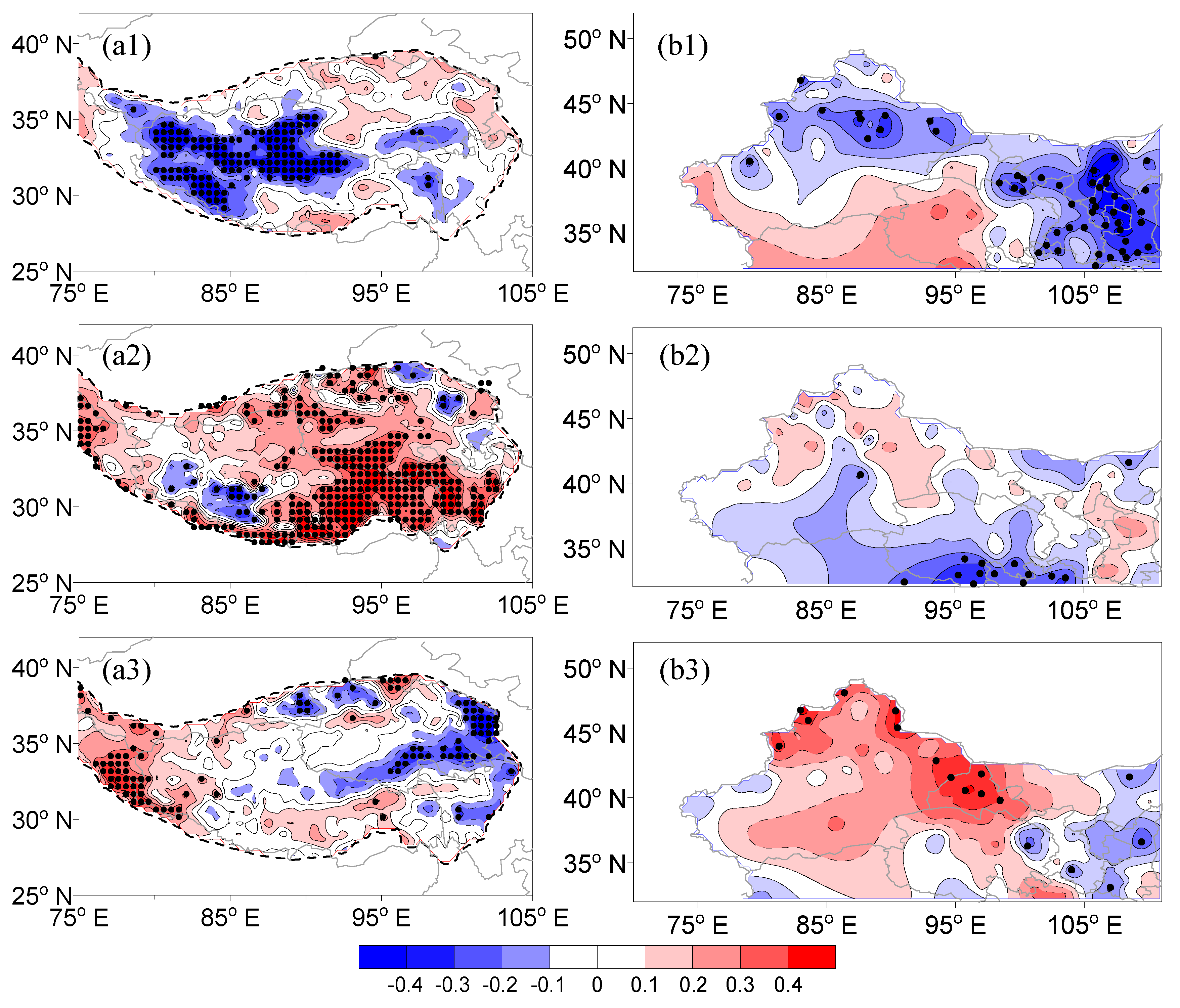
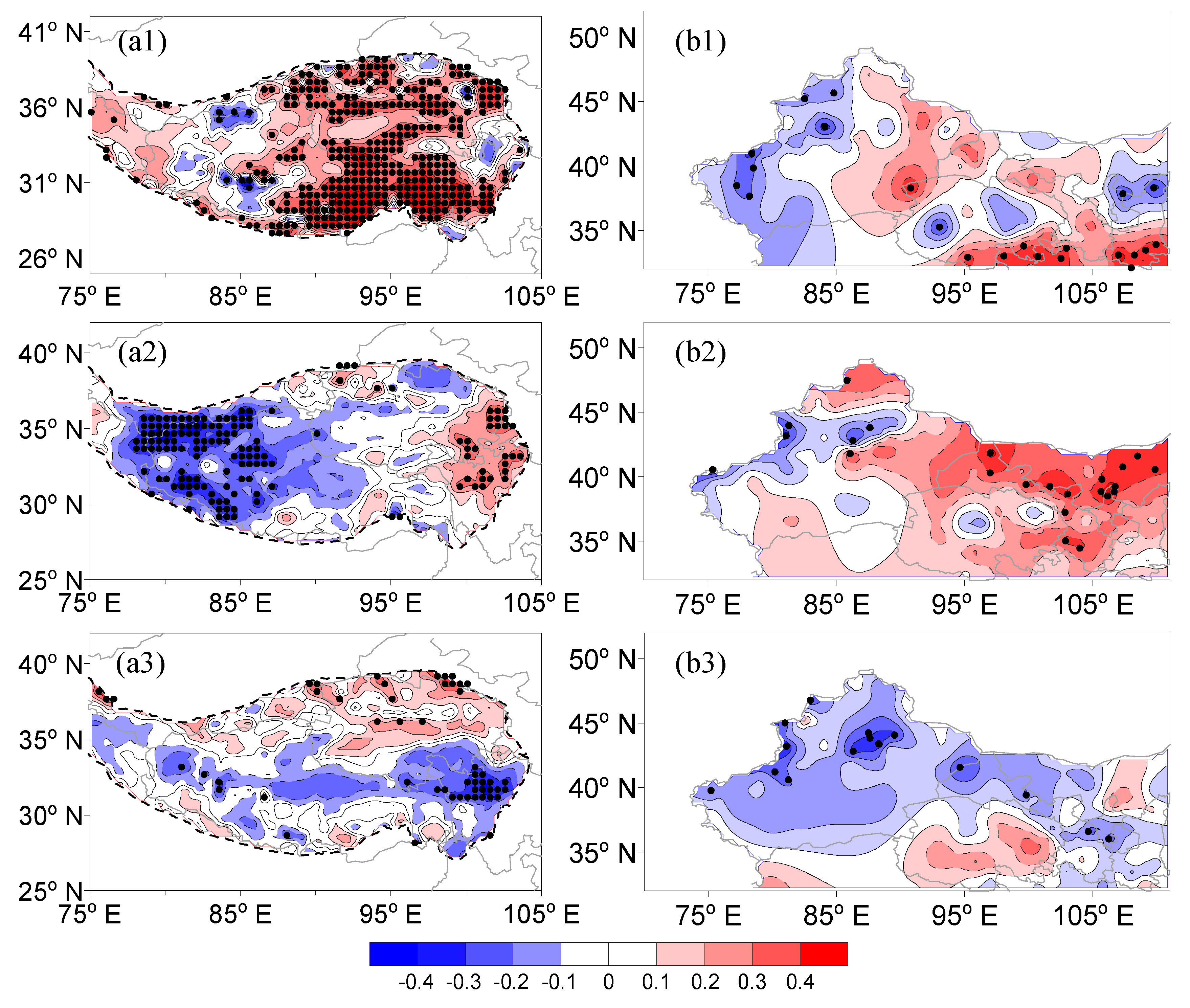

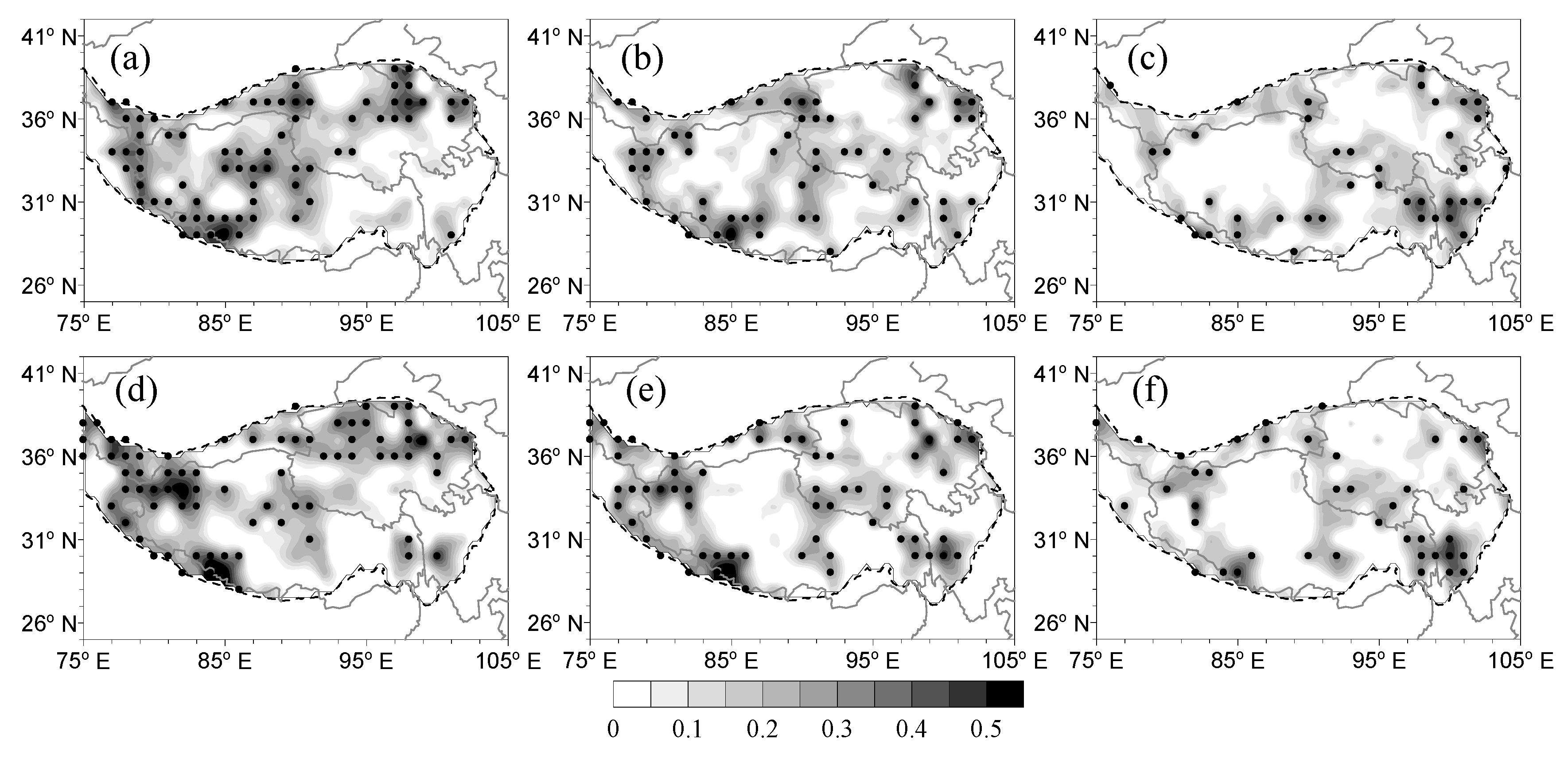
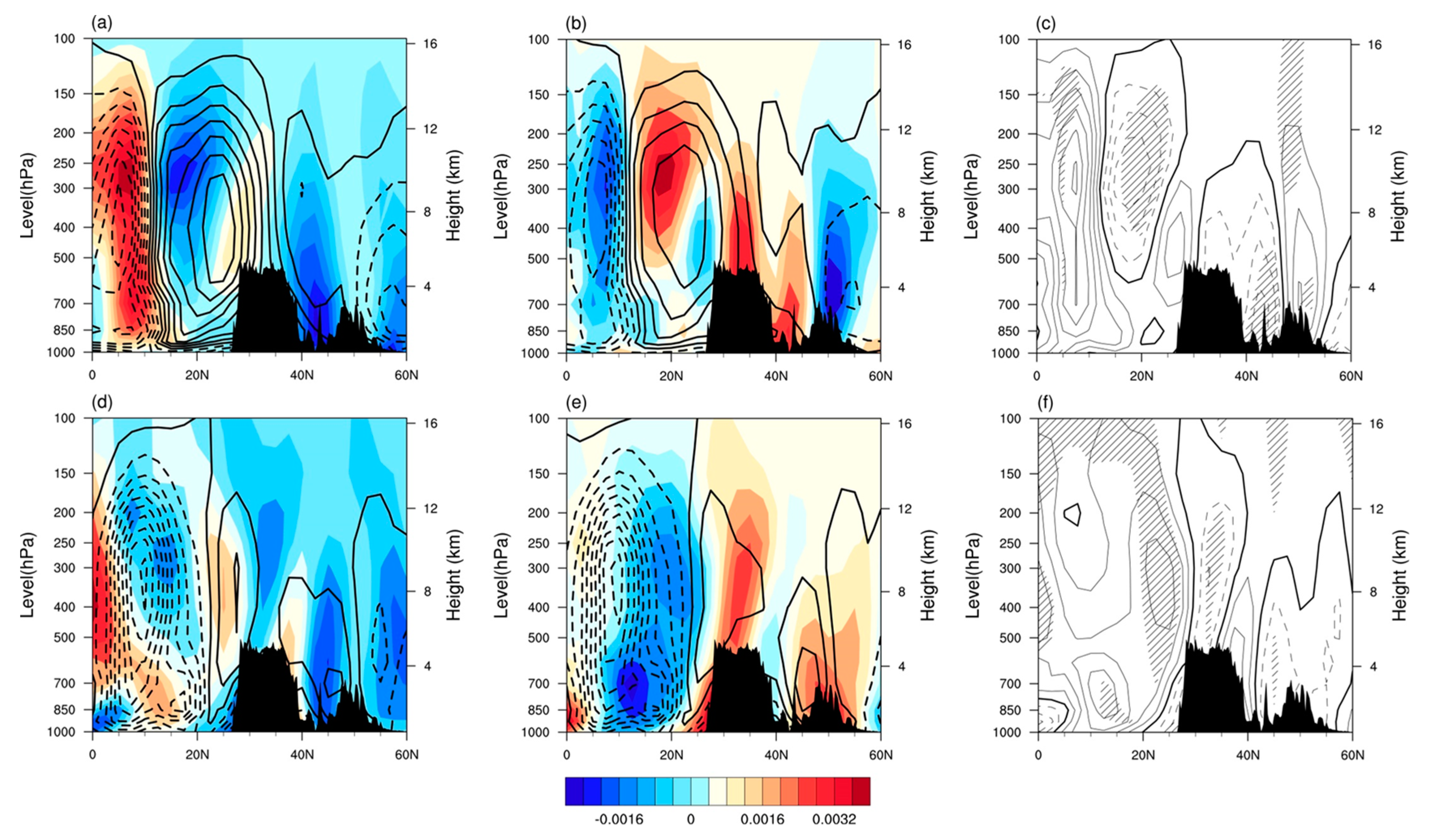
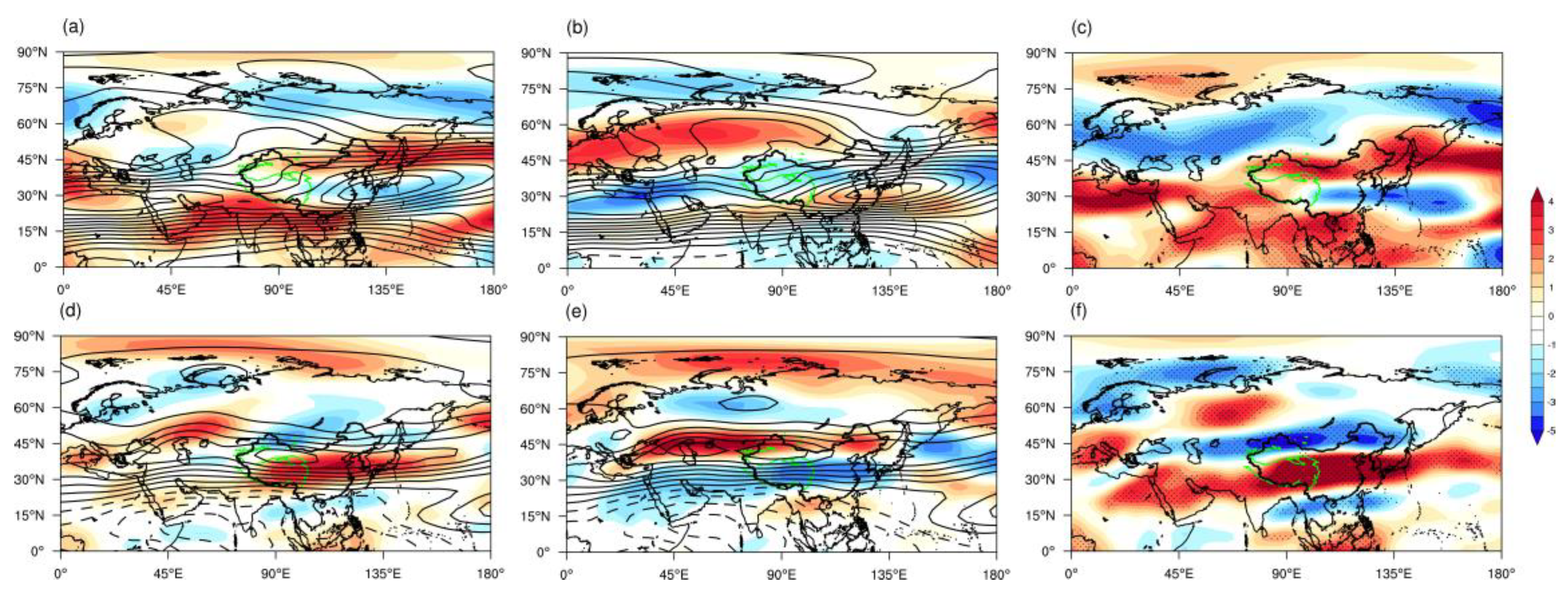

| First Mode | Second Mode | Third Mode | |
|---|---|---|---|
| Contribution (%) | 29.85 | 13.23 | 8.17 |
| Cumulative Contribution (%) | 29.85 | 43.08 | 51.25 |
| Correlation Coefficient | 0.66 | 0.75 | 0.78 |
| First Mode | Second Mode | Third Mode | |
|---|---|---|---|
| Contribution (%) | 21.04 | 15.34 | 10.95 |
| Cumulative Contribution (%) | 21.04 | 36.38 | 47.33 |
| Correlation Coefficient | 0.80 | 0.67 | 0.69 |
Disclaimer/Publisher’s Note: The statements, opinions and data contained in all publications are solely those of the individual author(s) and contributor(s) and not of MDPI and/or the editor(s). MDPI and/or the editor(s) disclaim responsibility for any injury to people or property resulting from any ideas, methods, instructions or products referred to in the content. |
© 2023 by the authors. Licensee MDPI, Basel, Switzerland. This article is an open access article distributed under the terms and conditions of the Creative Commons Attribution (CC BY) license (https://creativecommons.org/licenses/by/4.0/).
Share and Cite
Wang, Z.; Yang, K.; Zhang, F.; Zhang, J.; Sun, X. Impacts of Tibetan Plateau Spring Snowmelt on Spring and Summer Precipitation in Northwest China. Atmosphere 2023, 14, 466. https://doi.org/10.3390/atmos14030466
Wang Z, Yang K, Zhang F, Zhang J, Sun X. Impacts of Tibetan Plateau Spring Snowmelt on Spring and Summer Precipitation in Northwest China. Atmosphere. 2023; 14(3):466. https://doi.org/10.3390/atmos14030466
Chicago/Turabian StyleWang, Zhilan, Kai Yang, Feimin Zhang, Jinyu Zhang, and Xuying Sun. 2023. "Impacts of Tibetan Plateau Spring Snowmelt on Spring and Summer Precipitation in Northwest China" Atmosphere 14, no. 3: 466. https://doi.org/10.3390/atmos14030466
APA StyleWang, Z., Yang, K., Zhang, F., Zhang, J., & Sun, X. (2023). Impacts of Tibetan Plateau Spring Snowmelt on Spring and Summer Precipitation in Northwest China. Atmosphere, 14(3), 466. https://doi.org/10.3390/atmos14030466






